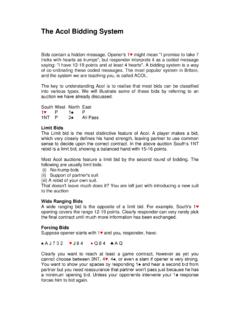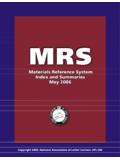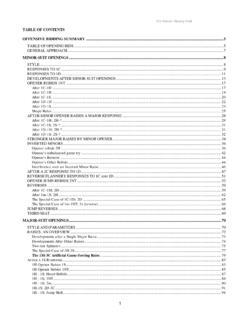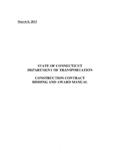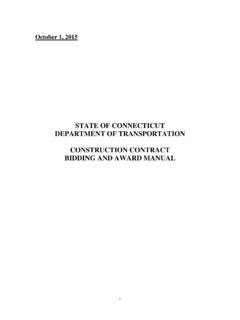Transcription of What Bidding Conventions Matter Most for the …
1 2010 Mike Purcell and Steve Moese. All Rights Reserved Learning Points 13 Conventions You Should Know by May 10, 2010 by Steve Moese (Mike Purcell ed.) Bidding LEVEL: Basic what Bidding Conventions Matter most for the new Duplicate Bridge Player? Good Conventions are 1) Simple and easy to remember and not prone to error, 2) Valuable they play an important role in improving your conversation with partner, 3) Additive they do not confuse what you can say or do with your normal Bidding system, and 4) Improve Your Results because you use them well and understand how to defend them when opponents use them against you. To work well, Conventions should fit in a logical framework or system. Consider starting with a standard framework like SAYC, Standard American (Richard Pavlicek) or 2/1 Game Force (Hardy, Lawrence, Grant/Rodwell).
2 Teachers and system proponents have eliminated much of the confusion, redundancy and overlap so things work together smoothly. Adding Conventions to a Bidding language is simpler if the language is standard. Let s start with a standard Bidding approach and a few basic assumptions that can work in any one of the 3 common natural Bidding systems. Let s assume Standard American framework: 1) 5 Card Majors; 1 promises 3 cards; 1 promises 4cards (except when 4432); 1NT = 15-17 HCP. 2) 2/1 by responder shows 11+ HCP and promises one more bid. (2/1 Game Force is popular with tournament players). 3) Responder s immediate Jump Shift is strong natural and forcing to game (preempt if they overcall). 4) Invitational Jumps: Jump support by responder or jump rebid by opener are INVITATIONAL.
3 So in an auction that goes 1 P 3 responder is INVITING game (SAYC/Standard American). Weak or Preemptive Jump Raises and Jump Shifts are not part of this Basic structure though they are popular with tournament players. 5) Weak 2 bids: 2 , 2 and 2 . Therefore 2 is a strong forcing opening. 6) Disciplined preempts in 1st and 2nd seats (Rule of 2-3-4) 7) Weak Jump Overcalls, and so are jump shifts after opponents overcall ( Jump Shift in Competition). Both are Disciplined (Rule of 2-3-4-5) 8) Fast Arrival. Once you are in a game forcing auction the more abrupt bid to game is weaker. (Compare this to Strong Picture Bids where a Jump implies strength in suits bid with no outside controls in unbid suits). 9) 3NT by responder at 1st bid shows 13-15 HCP balanced hand with 2-3 card fit for opener s suit.
4 10) Control Bidding (showing 1st and 2nd round control in a side suit) below game level. Here are 13 Conventions you should know on top of SAYC, Standard American (or 2/1 Game Force). Some have multiple variants or versions. All are common at duplicate bridge. 1N and 2N Opening 2 Invitational Stayman Smolen Transfer Bids Lebensohl After 1N or 2N Rebid New Minor Forcing Major Suits 2N Jacoby Major Raise Splinter Raises Competitive Bidding Negative Doubles Forcing Pass Slam Bidding Ace Asking Gerber / RKB 1430 4th Suit Forcing Competitive Bidding 2-Suit Bids After Opponents Open Interfering over Opponent s 1NT When adopting a new convention , pay attention to the meanings, how the new approach changes other Bidding sequences and inferences for your partnership, and what to do when opponents interfere.
5 Here is a list of links to follow for more details on these popular approaches. 2010 Mike Purcell and Steve Moese. All Rights Reserved 13 Conventions You Should Know By Rationale Considerations Links/How TO: No Trump Bidding 2 Invitational Stayman Helps find 4-4 major fits and improve scoring chances after we open 1NT. Useful adjunct: Crawling Stayman (responder has a very weak hand and wants to play in a 4-3 major fit at least. Some choose to play Puppet Stayman, a version built by 2/1 Game Force theorists to find a 5-3 major fit if partner opened 1NT with a 5 card major. Be sure to integrate with invitational hand and minor suit Bidding . Is 1N-P-2 -P-2 -P-3 forcing or weak? Are you playing Crawling Stayman?)
6 what response scheme are you using for Puppet Stayman? Playing Puppet Stayman gives up Garbage Stayman. Invitational Stayman Crawling Stayman Puppet Stayman Smolen When we hold a game forcing hand with 54+ in both majors opposite partner s1NT opening, we can find the right major game and ensure the 1NT bidder is the declarer (right-side the contract). Useful over both 1 and 2 NT openings. Smolen is a game force or slam invitation. Be sure to discuss the meaning of responders subsequent bids (controls, RKB, quantitative 4NT). Smolen Transfer Bids 4-Suit Transfers help bid long suits in a weak, invitational or strong hand opposite partner s 1NT opening. Major suit transfers are useful over the stronger 2NT opening. Texas Transfers help distinguish between slammish hands with a long major and hands simply interested in the major suit game.
7 Texas Transfers are usually weak, but some use TT to trigger RKB or Exclusion RKB. This preserves responder s 4NT as a quantitative inquiry after a simple major suit transfer. Delayed Texas is a useful add for a 6-4 major suit pattern and a weak hand after the auction goes 1N-P-2 -P-2 -P-?? You give up on 2NT as a natural invitation. This means you will use Stayman on some hands with no 4 card major if you want to invite a NT game. You will therefore alert responder s 2N rebid- Might be no 4 card major . Texas Transfers are ON if a jump in Competition some forget and think partner is making a natural Be sure you agree what 1N-P-2 -P-4 Be sure you agree what the Gap Bid means after partner transfers to either minor. Talk whether a minor transfer can have a 4-card major.
8 4-Suit Transfers Texas Transfers Lebensohl When opponents interfere at the 2-level over our 1NT opening, we need a way to show the difference between invitational and forcing hands, inquire about (the other) 4-card major(s), and identify whether we have their shown suit sufficiently stopped. You give up on 2NT as a natural invitation in competition. This is a small loss given the competitive Bidding advantages gained. Lebensohl Slam Bidding Ace Asking Once you ve found a fit and located controls, checking to be sure opponent s cannot win 2 fast tricks helps get to safer slams. RKB 1430 is marginally better than 0314 and much better than standard Blackwood. Gerber can be useful in NT auctions but many players choose to not use it at all or use it more widely than NT auctions risking confusion.
9 Playing RKB after a minor suit fit might make it hard to stop in game. Many play Gerber or Minorwood to deal with this. Be sure you know how partner responds to Gerber. Sometimes 4 is more useful as a control bid than an Ace ask. Beware! RKB 1430 Gerber 4th Suit Forcing Once 3 suits are mentioned by our side, the 4th suit cannot be a place to play. Instead theorists use this mechanism to drive to game and explore slam possibilities. Be sure to know the responses and the inferences about responder s major suit length and 4th suit holdings. This one is complex. 4th Suit Forcing 2010 Mike Purcell and Steve Moese. All Rights Reserved 1N Rebid New Minor Forcing helps bid accurately after opener s 1NT& 2NT rebid. Can be after 1 , 1 or 1 opening.
10 We cannot play 2 of the other minor in 1NT rebid auctions. Bidding weak hands with 4 card major and 6 card minor takes special care. Be sure to discuss what opener s rebids and responder s 3-level rebids mean. New Minor Forcing Major Suits 2N Jacoby Major Raise Allows the direct limit raise and promises a balanced game force with at least 4 trumps There are many response schemes. Pick the one that you like and will remember. Larry Cohen proposed an advanced version you might like. 2N Jacoby Major Raise Splinter Raises Since you use Jacoby 2NT for balanced game force hands with 4 trumps, splinter bids provide the unbalanced equivalent. Usually limited strength 11-15 HCP or so. Avoid splinters with a singleton Ace unless you have compensating values.
